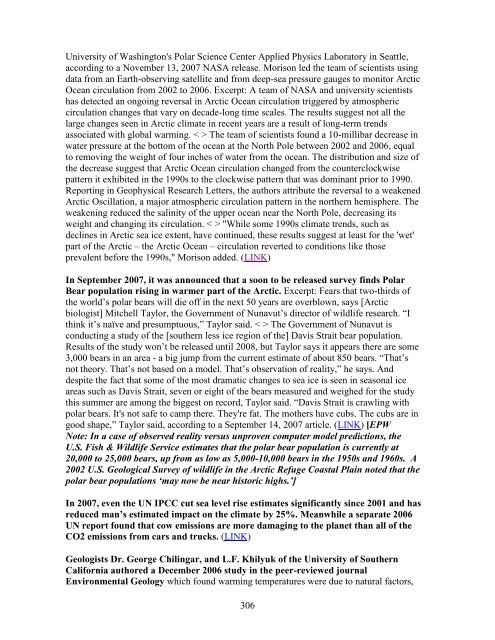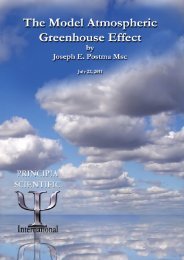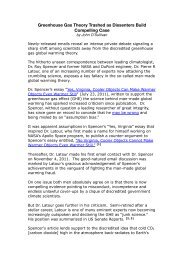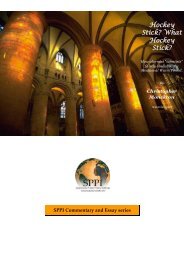Than 1000 International Scientists Dissent Over Man-Made Global ...
Than 1000 International Scientists Dissent Over Man-Made Global ...
Than 1000 International Scientists Dissent Over Man-Made Global ...
You also want an ePaper? Increase the reach of your titles
YUMPU automatically turns print PDFs into web optimized ePapers that Google loves.
University of Washington's Polar Science Center Applied Physics Laboratory in Seattle,<br />
according to a November 13, 2007 NASA release. Morison led the team of scientists using<br />
data from an Earth-observing satellite and from deep-sea pressure gauges to monitor Arctic<br />
Ocean circulation from 2002 to 2006. Excerpt: A team of NASA and university scientists<br />
has detected an ongoing reversal in Arctic Ocean circulation triggered by atmospheric<br />
circulation changes that vary on decade-long time scales. The results suggest not all the<br />
large changes seen in Arctic climate in recent years are a result of long-term trends<br />
associated with global warming. < > The team of scientists found a 10-millibar decrease in<br />
water pressure at the bottom of the ocean at the North Pole between 2002 and 2006, equal<br />
to removing the weight of four inches of water from the ocean. The distribution and size of<br />
the decrease suggest that Arctic Ocean circulation changed from the counterclockwise<br />
pattern it exhibited in the 1990s to the clockwise pattern that was dominant prior to 1990.<br />
Reporting in Geophysical Research Letters, the authors attribute the reversal to a weakened<br />
Arctic Oscillation, a major atmospheric circulation pattern in the northern hemisphere. The<br />
weakening reduced the salinity of the upper ocean near the North Pole, decreasing its<br />
weight and changing its circulation. < > "While some 1990s climate trends, such as<br />
declines in Arctic sea ice extent, have continued, these results suggest at least for the 'wet'<br />
part of the Arctic – the Arctic Ocean – circulation reverted to conditions like those<br />
prevalent before the 1990s," Morison added. (LINK)<br />
In September 2007, it was announced that a soon to be released survey finds Polar<br />
Bear population rising in warmer part of the Arctic. Excerpt: Fears that two-thirds of<br />
the world‘s polar bears will die off in the next 50 years are overblown, says [Arctic<br />
biologist] Mitchell Taylor, the Government of Nunavut‘s director of wildlife research. ―I<br />
think it‘s naïve and presumptuous,‖ Taylor said. < > The Government of Nunavut is<br />
conducting a study of the [southern less ice region of the] Davis Strait bear population.<br />
Results of the study won‘t be released until 2008, but Taylor says it appears there are some<br />
3,000 bears in an area - a big jump from the current estimate of about 850 bears. ―That‘s<br />
not theory. That‘s not based on a model. That‘s observation of reality,‖ he says. And<br />
despite the fact that some of the most dramatic changes to sea ice is seen in seasonal ice<br />
areas such as Davis Strait, seven or eight of the bears measured and weighed for the study<br />
this summer are among the biggest on record, Taylor said. ―Davis Strait is crawling with<br />
polar bears. It's not safe to camp there. They're fat. The mothers have cubs. The cubs are in<br />
good shape,‖ Taylor said, according to a September 14, 2007 article. (LINK) [EPW<br />
Note: In a case of observed reality versus unproven computer model predictions, the<br />
U.S. Fish & Wildlife Service estimates that the polar bear population is currently at<br />
20,000 to 25,000 bears, up from as low as 5,000-10,000 bears in the 1950s and 1960s. A<br />
2002 U.S. Geological Survey of wildlife in the Arctic Refuge Coastal Plain noted that the<br />
polar bear populations „may now be near historic highs.‟]<br />
In 2007, even the UN IPCC cut sea level rise estimates significantly since 2001 and has<br />
reduced man‟s estimated impact on the climate by 25%. Meanwhile a separate 2006<br />
UN report found that cow emissions are more damaging to the planet than all of the<br />
CO2 emissions from cars and trucks. (LINK)<br />
Geologists Dr. George Chilingar, and L.F. Khilyuk of the University of Southern<br />
California authored a December 2006 study in the peer-reviewed journal<br />
Environmental Geology which found warming temperatures were due to natural factors,<br />
306





